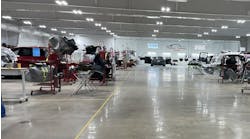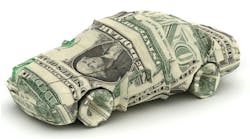Manage your insurer relationships by learning their side of the business
Having experience on both sides of the table, Wright says, is helpful but certainly not necessary for shops looking to boost their business through DRPs. He and others who have successfully obtained and maintained DRP agreements offer the following advice to shops looking to do the same.
Understand what's important to insurers
You don't have to become an insurance expert, but becoming familiar with key insurance numbers and ratios will help you show potential DRP partners you understand your role in helping them, Wright said.
"Severity," for example, refers to the costs of a claim — repair costs, rental car costs, etc. "Loss adjusting costs" are those related to settling a claim: the cost of employing adjusters, for example. A "combined ratio" divides the total costs of all claims expenses by the premiums the insurer receives.
Wright recommends keeping abreast of trends in these numbers for the insurance industry because as they change, insurer expectations will change. During slow-downs or declines in financial markets, for example, insurer combined ratios climb as their investment returns decline. This generally leads insurers to place greater emphasis on loss adjusting costs and severity.
Wright said shops will generally get an insurer's attention if they can show how something they are offering will save the insurer money, particularly if that savings is extrapolated over a year or two. Don't just tell an insurer you have better cycle time (the number of days a vehicle is in your shop), for example; show them what that means for them.
"If you save an insurer four days of rental car expense at $25 a day, it's $100," Wright says. "You extrapolate that out for 52 weeks, and for an insurer doing 10,000 claims a week, it's $18.2 million of savings. Offer that value to the insurance company that says it makes sense to partner with you."
Identify the insurers with whom you want to work
Participating in only one or two DRPs may make your business far too dependent on one insurer, said Clark Plucinski, a founder and executive vice president of True2Form Collision Repair, a repair chain with more than 35 shops in four states. On the other hand, he said, trying to manage the 10 different requirements of 10 different DRPs also might not make sense.
"In our case, we've chosen to focus on five or six insurers in each of our markets," Plucinski said.
Wright recommends spending some time developing a chart that shows the top insurers in your area, how much repair work each is likely to have, how much of that work your shop currently does for that insurer, and what your gross profit margin is for that insurer's work.
This type of chart can help you decide which insurers to pursue — because, for example, they offer a lot of opportunity for more work, or because your profit margin on their work is better.
Learn whom to negotiate with – and how
"Knowing the president of Allstate Insurance won't necessarily bring cars to your door, but it certainly makes sense to know as many levels of people within the insurer as you can, and to build relationships with most of them," Plucinski says.
That has to start, however, on a local level.
"Even if a decision about what shops get on a DRP is made at the regional level, the regional person is going to ask the local people who should get on," Wright says. "If you've alienated that local person, your chances may be slim to none."
Build those relationships by asking local insurance personnel about how their performance is being measured and how you can help them achieve those targets, Wright said.
Persistence also can pay off, Plucinski said. An insurer may not need any more shops in your area on its DRP today, but that can change as more claims go through the program.
It's also good to consider whether you are the best person to interact with the insurers during the "sales" and negotiating process.
"You have to really be able to sell yourself," says Plucinski. "Too often, we're good at fixing cars, but not as good at going over to knock on the door of the local insurance office.
"You may not be the best person to go talk to the insurance representatives on behalf of your shop. You might have to find some person to do that."
Also, be sure to read any DRP agreements carefully, and consider having your attorney review them as well. Some insurers view them as unilateral, which means you sign them as is or you're not on the program. Others may be more willing to negotiate on some aspects of the agreement.
Maintain the relationships you create
The DRP agreement paper is signed, the referrals are starting to happen — you're set, right? Not so fast, Plucinski and Wright caution. Getting on a DRP is only the first hurdle; now you have to stay on it and make it work for your business.
"It can take two years to build a relationship with an insurer," Plucinski says. "My expression is: Two years to build, two minutes to lose."
Make sure you and key office staff understand all of the DRP procedures and policies — then follow them closely. Unless an insurer is down-sizing the number of shops on the program in a market, it isn't looking for reasons to kick you off. After all, adding or changing the shops on the DRP can be a hassle for them. But you won't get the benefits of participating forever if you don't follow through with the responsibilities.
Preparing for turnover is critical. You may get along great with your current re-inspector from a particular insurance company, but one day you may find yourself butting heads with his or her successor. That's when it's helpful to have developed a good relationship higher up in the claims office to help work through any tough situations.
You'll also want to prepare a "standard charges" manual for each insurer. This manual will spell out what and how you will charge for various items and procedures. If you can, get the insurer to also sign the manual to help protect you if a new insurance company reinspector seems to have different expectations than you agreed to.
Also ask the insurer to share with you the results of the re-inspection audits of your shop. These will help you gauge how you are meeting the insurer's needs. Again, having a good understanding of both the insurer's numbers and your own shop's numbers can be critical. An insurer, for example, may indicate that your "severity" is higher than other shops on the program. But severity on third-party claims is always higher than on first-party claims because there is no deductible and they often include rental vehicle and other charges that aren't as commonly included with first-party claims. So knowing the mix of first- and third-party claims you've had can help you explain a higher severity rate.
Avoid getting defensive when an insurer points out areas of your performance that need improvement.
"What you can't do is be at the bottom of the pack and always arguing with the insurer about why it's OK that you're down there compared to the rest of the local shops on the program," Plucinski says.
Final word: building bonds
While not every collision repair business chooses to participate in DRPs, there's no question that an increasing percentage of insurance claims are being handled through such arrangements.
"Whether you participate in DRPs is your own business decision," Wright says. "But I think it's important to understand how to obtain and manage DRP relationships if it's something you choose to pursue."




